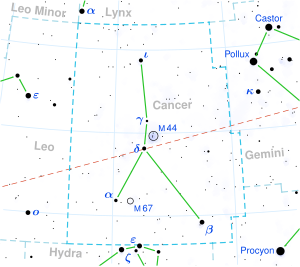| Observation data Epoch J2000.0 Equinox J2000.0 | |
|---|---|
| Constellation | Cancer |
| Right ascension | 09h 00m 23.594s[1] |
| Declination | +21° 50′ 05.43″[1] |
| Apparent magnitude (V) | 16.11[2] |
| Characteristics | |
| Evolutionary stage | Main-sequence star[2] |
| Spectral type | M6.5 V[3] |
| Apparent magnitude (J) | 9.44[2] |
| Astrometry | |
| Radial velocity (Rv) | 23.3[2] km/s |
| Proper motion (μ) | RA: -514.942 mas/yr[4] Dec.: -592.253 mas/yr[4] |
| Parallax (π) | 157.2686 ± 0.0535 mas |
| Distance | 20.739 ± 0.007 ly (6.359 ± 0.002 pc) |
| Details | |
| Mass | 0.09[5] M☉ |
| Radius | 0.12[6] R☉ |
| Luminosity | 0.00082[7] L☉ |
| Temperature | 2680±24[7] K |
| Metallicity [Fe/H] | -0.06±0.17[8] dex |
| Rotation | 0.439 d[6] |
| Rotational velocity (v sin i) | 15.0±1.0[6] km/s |
| Other designations | |
| Database references | |
| SIMBAD | data |
Location of LHS 2090 in the constellation Cancer | |
LHS 2090 is a red dwarf star of spectral type M6.5V, located in constellation Cancer at 20.8 light-years from Earth.[10]
The star was identified to be a red dwarf at short distance (6 parsecs from Sun) in 2001.[11] As typical for very cool red dwarfs, its spectrum is dominated by molecular water absorption. Stellar metallicity is similar to that of Sun`s.[8]
Radial velocity measurements did not yield any detection of stellar companion or giant planet on orbit around LHS 2090, as in 2018.[2]
- ^ a b Cutri, R. M.; et al. (2003). "2MASS All-Sky Catalog of Point Sources". VizieR On-line Data Catalog. Bibcode:2003yCat.2246....0C.
- ^ a b c d e Henry, Todd J.; Jao, Wei-Chun; Winters, Jennifer G.; Dieterich, Sergio B.; Finch, Charlie T.; Ianna, Philip A.; Riedel, Adric R.; Silverstein, Michele L.; Subasavage, John P.; Vrijmoet, Eliot Halley (2018), "The Solar Neighborhood XLIV: RECONS Discoveries within 10 parsecs", The Astronomical Journal, 155 (6): 265, arXiv:1804.07377, Bibcode:2018AJ....155..265H, doi:10.3847/1538-3881/aac262, S2CID 53983430
- ^ Alonso-Floriano, F. J.; Morales, J. C.; Caballero, J. A.; Montes, D.; Klutsch, A.; Mundt, R.; Cortés-Contreras, M.; Ribas, I.; Reiners, Ansgar; Amado, P. J.; Quirrenbach, A.; Jeffers, S. V. (2015). "CARMENES input catalogue of M dwarfs" (PDF). Astronomy & Astrophysics. 577: A128. arXiv:1502.07580. Bibcode:2015A&A...577A.128A. doi:10.1051/0004-6361/201525803. S2CID 53135130.
- ^ Brown, A. G. A.; et al. (Gaia collaboration) (2021). "Gaia Early Data Release 3: Summary of the contents and survey properties". Astronomy & Astrophysics. 649: A1. arXiv:2012.01533. Bibcode:2021A&A...649A...1G. doi:10.1051/0004-6361/202039657. S2CID 227254300. (Erratum: doi:10.1051/0004-6361/202039657e). Gaia EDR3 record for this source at VizieR.
- ^ Davison, Cassy L.; White, R. J.; Henry, T. J.; Riedel, A. R.; Jao, W-C.; Bailey Iii, J. I.; Quinn, S. N.; Cantrell, J. R.; Subasavage, J. P.; Winters, J. G. (2015), "A 3D Search for Companions to 12 Nearby M Dwarfs", The Astronomical Journal, 149 (3): 106, arXiv:1501.05012, Bibcode:2015AJ....149..106D, doi:10.1088/0004-6256/149/3/106, S2CID 9719725
- ^ a b c Cite error: The named reference
Fouque2017was invoked but never defined (see the help page). - ^ a b Dieterich, Sergio B.; Henry, Todd J.; Jao, Wei-Chun; Winters, Jennifer G.; Hosey, Altonio D.; Riedel, Adric R.; Subasavage, John P. (2013), "The Solar Neighborhood. Xxxii. The Hydrogen Burning Limit", The Astronomical Journal, 147 (5): 94, arXiv:1312.1736, doi:10.1088/0004-6256/147/5/94, S2CID 21036959
- ^ a b Rojas-Ayala, Bárbara; Covey, Kevin R.; Muirhead, Philip S.; Lloyd, James P. (2011), "Metallicity and Temperature Indicators in M Dwarfk-Band Spectra: Testing New and Updated Calibrations with Observations of 133 Solar Neighborhood M Dwarfs", The Astrophysical Journal, 748 (2): 93, arXiv:1112.4567, doi:10.1088/0004-637X/748/2/93, S2CID 41902340
- ^ "LHS 2090". SIMBAD. Centre de données astronomiques de Strasbourg. Retrieved 29 January 2018.
- ^ Cite error: The named reference
Henry2006was invoked but never defined (see the help page). - ^ Scholz, R.-D.; Meusinger, H.; Jahreiß, H. (2001), "Search for nearby stars among proper motion stars selected by optical-to-infrared photometry", Astronomy & Astrophysics, 374 (2): L12–L15, arXiv:astro-ph/0106222, doi:10.1051/0004-6361:20010811, S2CID 8488435
